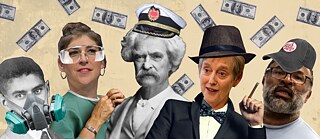At Work with Kafka
Ten Geniuses with Unusual Professions

Not only was Franz Kafka a writer. He also had to work throughout his life at an office to make ends meet. And he wasn’t the only one. Here are ten examples of creative minds with monotonous, absurd jobs.
By Guillermo Martínez
“Franz Kafka (1883–1924), author of Metamorphosis, The Trial and The Castle; the first modern writer” – that’s perhaps the most common description of the Prague artist’s work. Another would be: “Kafka, the employee at the Workers’ Accident Insurance Institute”. That is where he would perform the most boring tasks, far from his passion as a writer, during a fixed work shift. He would go there every day between 1908 and 1922, from 8am to 2pm, to supplement his income as a writer. But it was not his only job; Kafka also ended up working as a businessman at a company called “Prager Asbestwerke Hermann & Co”.
Finding Artistic Inspiration at Work
Although Mark Twain (1835–1910) is known throughout the world as the author of timeless novels like The Adventures of Tom Sawyer or The Adventures of Huckleberry Finn, his beginnings were forged in different professions that were completely removed from that of a writer. Samuel Langhorne Clemens, the American literary figure’s real name, was a steam ship pilot, a soldier in the American Civil War, a miner in Nevada, a timber merchant and, finally, a journalist.Stella Rimington (*1935) wrote her first novel in 2004. Before that, this Londoner was the first woman to hold the position of Director General of the British Security Services, known as the MI5, from 1992 to 1996. That past led Stella Whitehouse, as she was called before marrying and changing her last name, to write her first extensive account based on a terrorist who was impossible to find. The title: At Risk. Later, several detective novels would follow.
Their Beginnings Were Never Easy
First a secretary at the Pentagon and a cover singer, then a successful actress. These are the experiences that Taraji P. Henson (*1970) has accumulated. In the afternoons, she would sing and dance on a cruise ship, while in the mornings she worked for the government, as did some members of her family. But it was not until 2001 that she rose to fame for her role in the film Baby Boy.Henry Miller (1891–1980) was one of those people who suffered from the censorship of his books throughout the 20th century. Before this, he had become Head of Personnel at the Western Union Telegraph Company, the telephone and telegraph company. The author of books, such as Tropic of Cancer and Tropic of Capricorn, he did not find his place in literature until he was forty. Later, the provocative content of his creations would be met with censorship, something that would influence the subsequent Beat Generation.
Bored in their Big Company Offices
The case of Wallace Stevens (1879–1955) is not so far from that of our protagonist, Kafka, either. This American poet also opted for the insurance field at the Hartford Accident and Indemnity Company where he worked as a lawyer. In fact, he worked there until his death, so he always combined his poetic side with his performance at his office job.And what if Harper Lee (1926–2016) had continued her job as a telephone operator at an airline where she took ticket reservations? Well, we certainly would have never had works like To Kill a Mockingbird. In fact, she left Eastern Airlines because a friend advised her to take some time to focus on her literary career. She did just that and published her best-known work.
Confusing the Person with the Character
The name Mayim Bialik (*1975) is perhaps not as well-known as Amy in The Big Bang Theory series. In reality, they are one and the same person, though the first gave life to the second. In fact, this Californian studied neuroscience for seven years. She currently combines acting with teaching about neuroscience.Geoffrey Owens (*1961) became famous for his appearance in the acclaimed The Cosby Show. Few knew then that before all that he worked in a chain supermarket called Trader Joe’s. When he made that public, some laughed at him on social media. The response was immediate: well-known figures from the entertainment world and many other social media users supported him. “There are no jobs that are better than others. Every job is important and valuable,” the actor later commented.
More recent is Peter Hein (*1957), the singer of the German punk band Fehlfarben (false colors in English). In an interview with the German magazine Der Spiegel, he said that he could never earn a living solely from his music. “Perhaps you could go on a vacation, but nothing more,” he emphasized. Without going any further, the singer stated that he will always be part of a workforce: “Before Fehlfarben, during Fehlfarben and after too,” he said in reference to the success the punk group achieved decades earlier. The decision that Peter Hein made was in line with punk ideology: to rather be a worker with a precarious life than become a pop star. That led him to notice firsthand how business ups and downs tend to target the weakest links in the chain, in other words, the rank-and-file employees.
Making a living as an artist, whether as a filmmaker, a writer or a musician, is not easy, at least not at first. Many people who have achieved worldwide success, some by vocation and most out of necessity, did not always fully commit themselves to what would make them popular years later. Many others did combine both sides, without letting one eclipse the other. Through his own experience, Kafka made it very clear that inspiration and imagination are not at odds with work. How many people appear to have a simple and boring job, but actually have a whole world inside of them?